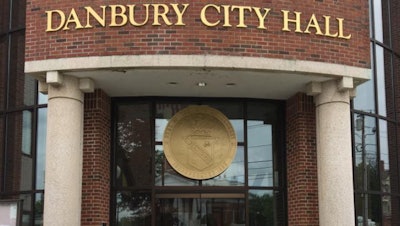
DANBURY, Conn. (AP) — When contractors rip open a section of Kennedy Avenue later this year to repair a 56-year-old bridge, they will also expose a section of the Still River with a conflicted city history.
The $3 million Kennedy Avenue bridge repair project will uncover a stretch of the Still River that suffered decades of industrial pollution during the city’s heyday as the hat capital of the world — and inflicted back-to back floods on the downtown in 1955.
“The floods were emotionally traumatic as well as physically devastating, so there was a strong push to do something concrete that would prevent this from happening again,” says Brigid Guertin, executive director of the Danbury Museum and Historical Society. “So the Still River had to be banished.”
City engineers channeled it into a deep sleeve of concrete under Main Street so it could never flood again.
Today, in order to get at the bridge and culvert, workers will have to disrupt a section of Main that has become a symbol of renewal.
Kennedy Avenue is now home to the newly build 375-unit Kennedy Flats complex, and also Kennedy Park, where City Hall has promoted lunch truck and market events to spark more street life downtown.
“It’s an important visual piece and one of the first things you see when you drive into downtown, so we’re trying to figure out if we are going to restore it as part of this project or provide all the amenities necessary to accommodate a nice park when we do our sidewalk project,” said Antonio Iadarola, Danbury’s public works director and acting city engineer. “Obviously this is the downtown and we have to keep the traffic moving - so we will be alternating traffic and doing segmented construction work.”
The project will also disrupt service on the HART bus, which has a depot on Kennedy Avenue.
The Kennedy Avenue project, which is expected to go out to bid in the spring and begin later this year, is part of a larger schedule of bridge maintenance.
Repairs to the Triangle Street bridge near the Department of Motor Vehicles were completed last year, for example. And in April, voters will be asked to approve $18 million in borrowing to repair four more bridges as part of a larger $62 million bond project.
Plans to restore the Kennedy Avenue bridge include patching beams, installing a waterproof membrane across the top of the bridge, and applying a carbon fiber laminate on the bottom of the bridge to increase its carrying capacity.
Danbury built the bridge in 1964 - one decade before the Army Corps of Engineers channeled a larger portion of the Still River further downstream.
“We’re lucky the deterioration hasn’t gone too far,” said Thomas Altermatt, the city’s project manager. “We’re lucky that after 56 years, the beams are still in pretty good condition.”
Uncovering the old bridge may also be an occasion to educate people about Danbury’s most notorious natural disaster.
“If you’re a school child or if you have just come to Danbury, you generally have no idea that the Still River runs through our Main Street corridor, and that it is part and parcel of the community,” the museum’s Guertin said. “It’s not visual in the way that it was visual for hundreds of years.”
Repairing and reminiscing
On paper the Kennedy Avenue Bridge is one of 70 local bridges over the brooks, streams and rivers of Danbury, but to historians, it’s an engineering feat that was completed as part of a larger urban renewal program.
“That is the fun of this job,” Iadarola said during an interview last week in his City Hall office, reviewing bridge plans so old they were hand drawn on blue drafting paper. “We get to go back in history when we work on projects like this.”
The 1964 bridge and concrete culvert that channels the Still River under Kennedy Avenue is not to be confused with the much larger $14 million project undertaken downstream by the Army Corps of Engineers in 1974 to realign the river in a 3,600-foot concrete conduit.
The goal was to keep the river from overtaking its banks and ruining downtown life as it did twice in 1955.
The floods followed a century of factories dumping mercury and other toxins into the river, and developers building on its floodplains.
“The massive flooding we had caused unbelievable damage into the millions of dollars not once but twice,” Guertin said. “Sometimes that period is referred to as the river’s revenge.”
As a result, the Still River is sunk deep below the street level with tall concrete walls in place of banks, making it invisible to the unaware.
Nor are many people in Danbury other than natives likely to know there’s a Kennedy Avenue bridge.
“If you look at it, you wouldn’t even think there is a bridge there,” Iadarola said.
The Kennedy Avenue bridge has a “poor” rating of 4 out of 9 for its superstructure, and a “satisfactory” rating of 6 out of 9 for its substructure.
Much of the deterioration is due to corrosive road-treating materials that have eaten away the concrete to expose tension strands.
“If those tension strands pop, you lose all the carrying capacity,” Iadarola said.
The state has pledged to pay half of the restoration costs.
Once it is restored, it’s possible that in the not-so-distant future the city will seek to develop the area around the visible part of the riverbank as a scenic asset and attractive part of downtown.
While there are challenges ahead, some of the city’s dreamers see its currents rippling through a park with a walking path and maybe thriving outdoor cafes where residents can dine and drink and watch the river flow.






















